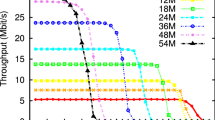Abstract
In the 802.11b networks, the guarantee of an equal long-run channel access probability causes performance anomaly in a multi-rate wireless cell. Much interest has been involved in this issue and many effective mechanisms have been proposed. The usual MAC layer solutions include the initial contention window adaptation, the maximum transfer unit size adaptation and the packet bursting. In this paper, we propose a novel approach which introduces a new parameter called the transmission probability p t to the legacy protocol. By adjusting p t according to the transmission rate, the proposed scheme can solve the performance anomaly problem cleanly. Throughput analysis and performance evaluation show that our scheme achieves significant improvement in the aggregate throughput and the fairness.
Similar content being viewed by others
References
Bianchi, G., 2000. Performance analysis of the IEEE 802.11 distributed coordination function. IEEE JSAC, 18(3):535–547. [doi:10.1109/49.840210]
Dunn, J., Neufeld, M., Sheth, A., Grunwald, D., Bennett, J., 2006. A practical cross-layer mechanism for fairness in 802.11 networks. Mobile Networks and Applications, 11(1):37–46. [doi:10.1007/s11036-005-4459-z]
Garroppo, R.G., Giordano, S., Luceti, S., Tavanti, L., 2007. Providing air-time usage fairness in IEEE 802.11 networks with the deficit transmission time (DTT) scheduler. Wireless Networks, 13(4):481–495. [doi:10.1007/s11276-006-9201-7]
Heusse, M., Rousseau, F., Berger-Sabbatel, G., Duda, A., 2003. Performance Anomaly of 802.11b. INFOCOM, p. 836–843.
Iannone, L., Rousseau, F., Berger-Sabbatel, G., Duda, A., 2005. Idle Sense: An Optimal Access Method for High Throughput and Fairness in Rate Diverse Wireless Lans. SIGCOMM, p. 121–132.
Jain, R., 1999. Throughput Fairness Index: An Explanation. ATM Forum/99-0045.
Kim, H., Yun, S., Kang, I., Bahk, S., 2005. Resolving 802.11 performance anomalies through QoS differentiation. IEEE Commun. Lett., 9(7):655–657. [doi:10.1109/LCOMM.2005.1461695]
Li, B.J., Soung, C.L., 2005. Proportional Fairness in Wireless LANs and Ad Hoc Networks. WCNC, 3:1551–1556. [doi:10.1109/WCNC.2005.1424745]
Razafindralambo, T., Lannone, L., 2006. Dynamic Packet Aggregation to Solve Performance Anomaly in 802.11. MSWIM. Torremolinos, Malaga, Spain, p.247–254. [doi:10.1145/1164717.1164761]
Sadeghi, B., Kanodia, V., Sabharwal, A., Knightly, E., 2002. Opportunistic Media Access for Multi-rate Ad Hoc Networks. MOBICOM, p.486–497.
Tan, G., Guttag, J., 2004. Time-based Fairness Improves Performance in Multi-rate WLANs. USENIX, p.269–282.
Yoo, S., Choi, J., Hwang, J., Yoo, C., 2005. Eliminating the performance anomaly of 802.11b. LNCS, 3421:1055–1062.
Author information
Authors and Affiliations
Corresponding author
Additional information
Project supported by the National Mid-and Small-Scale Enterprise Technical Innovation Fund of China (No. 06C26225101730) and the Sichuan Provincial Key Science and Technology Program, China (No. 05GG021-003-2)
Rights and permissions
About this article
Cite this article
Cheng, Yh., Li, Zs., Xing, Jc. et al. A novel MAC mechanism to resolve 802.11 performance anomaly. J. Zhejiang Univ. - Sci. A 8, 1573–1583 (2007). https://doi.org/10.1631/jzus.2007.A1573
Received:
Revised:
Published:
Issue Date:
DOI: https://doi.org/10.1631/jzus.2007.A1573




